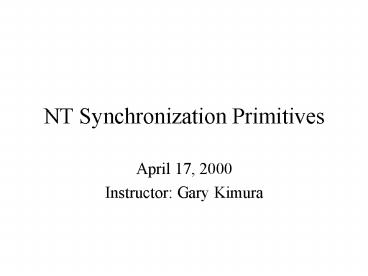NT Synchronization Primitives - PowerPoint PPT Presentation
Title:
NT Synchronization Primitives
Description:
... There is an optional timeout on the wait calls that will return from the wait call even if ... A spinlock is a quick mechanism for acquiring ... – PowerPoint PPT presentation
Number of Views:17
Avg rating:3.0/5.0
Title: NT Synchronization Primitives
1
NT Synchronization Primitives
- April 17, 2000
- Instructor Gary Kimura
2
Kernel Support for Synchronization
- Spinlocks
- Interlocked Operations
- Events
- Semaphores
- Mutex
- Eresource
3
Spinlocks
- A spinlock is a quick mechanism for acquiring
exclusive access to a critical section of code - It uses Interrupt Request Levels (IRQL) to
disable other code from running - Kernel spinlock calls are
- KeAcquireSpinLock Enter critical section
- KeReleaseSpinLock Leave critical section
- On UP systems spinlocks are implemented by
raising the Interrupt Request Level - On MP systems spinlocks are implemented using a
shared variable that contains the owners thread
ID - Look at handout for MIPS 4000 coding example
4
Interlocked Operations
- Interlocked operations are atomic operations that
can be used to synchronize access to a single
variable or as a building block for more complex
synchronization routines - Some of the supported interlocked operations are
- InterlockedIncrement
- InterlockedDecrement
- InterlockedCompareExchange
- and there are more
5
X86 Interlocked Exampleslock prefix is MP only
- __inline
- LONG FASTCALL
- InterlockedIncrement(
- IN PLONG Addend )
- __asm
- mov eax, 1
- mov ecx, Addend
- lock xadd ecx, eax
- inc eax
- where xadd atomically does
- temp eax ecx
- eax ecx
- ecx temp
- __inline
- LONG FASTCALL
- InterlockedCompareExchange(
- IN OUT PLONG Destination,
- IN LONG Exchange,
- IN LONG Comperand )
- __asm
- mov eax, Comperand
- mov ecx, Destination
- mov edx, Exchange
- lock cmpxchg ecx, edx
- where cmpxchg atomically does
- if eax ecx
- ecx edx
- else
6
Events and Semaphores
- There are two types of events
- Synchronization events used to allow one thread
at a time to enter a critical region of code - Notification events used to signal all the
threads about an event - The Semaphore is a plain counted Semaphore
- Waiting for an event or a semaphore uses the same
routines - KeWaitForSingleObject
- KeWaitForMultipleObjects
7
Events
- An event variables state is either signaled or
not-signaled. - Threads can wait for an event to become signaled
- Kernel event calls are
- KeClearEvent Event becomes not-signaled
- KePulseEvent Atomically signal and then
not-signal event - KeReadStateEvent Returns current event state
- KeResetEvent Event becomes not-signaled and
returns previous state - KeSetEvent and KeSetEventBoostPriority Signal an
event and optionally boost the priority of the
waiting thread
8
Semaphores
- A semaphore variable is just a plain old vanilla
counted semaphore, but its implementation shares
much of the event logic - Kernel semaphore calls are
- KeReadStateSemaphore Returns the signal state of
the semaphore - KeReleaseSemaphore Takes as input a release
count and a priority boost of the newly released
threads
9
Wait for routine
- The kernel supports two major wait routines.
These routines can be used by threads to wait for
events, semaphores, queues, timers, etc. - Kernel wait calls are
- KeWaitForSingleObject Wait for one event or
semaphore to become signaled - KeWaitForMultipleObjects Wait for one or more
events or semaphores (WaitAny or WaitAll) - There is an optional timeout on the wait calls
that will return from the wait call even if the
object is not signaled
10
Executive Mutex
- A mutex looks like a spinlock from the
programmers viewpoint but a mutex allow recursion
and page faults - Operations are
- ExAcquireFastMutex Enter critical region
- ExReleaseFastMutex Exit critical region
- ExTryToAcquireFastMutex Like acquire but return
immediately without blocking and indicate if we
acquired the mutex - The executive mutex is implemented using kernel
synchronization events - A note regarding Kernel versus Executive routines
11
Executive Resource
- The Executive Resource (Eresource) package is
used by NT kernel level code to handle the
multi-reader/single-writer access to protected
data structures. - The package exports a typedef called an Eresource
- Operations are
- ExAcquireResourceShared
- ExAcquireResourceExclusive
- ExAcquireSharedStarveExclusive
- ExReleaseResource (ExReleaseResourceForThread)
- ExConvertExclusiveToShared
12
Eresource features
- A resource can be acquired recursively
- The ownership of a resource is tied to a thread
ID - The users get to decide whether exclusive waiters
starve - The package automatically handles priority
inversion - The routines are implemented using spinlocks,
events, and semaphores - More details at a later lecture































